NFL Photos | NFL Photography Gallery | NFL.com
From the Hall of Fame Archives: The 1970's All-Decade Team

Hall of Fame defensive end Alan Page applies pressure on Green Bay Packers Hall of Fame quarterback Bart Starr in a 1970s game at Lambeau Field. Page won the starting defensive right tackle job in the fourth game of his 1967 rookie season and he remained a starter for the rest of his career. Alan excelled with the Vikings for 11 seasons and six games into the 1978 campaign, when he was waived. The Chicago Bears quickly signed him and he moved into the starting lineup without missing a game. Page wound up his career in 1981 after playing 238 games, all but three of them as a starter. Included were 16 NFL/NFC playoff games and Super Bowls IV, VIII, IX, and XI.(Photo by Vernon Biever/NFL)

Pro Football Hall of Fame offensive tackle, Art Shell (78) and center Jim Otto of the Oakland Raiders. Art Shell, a third-round draft pick of the Oakland Raiders in 1968, excelled on the special teams for two seasons before winning the starting offensive left tackle job in his third campaign. Within a short time, he became widely recognized as one of the premier offensive linemen in the National Football League. He also played in eight Pro Bowl games and 23 post-season contests, including eight AFL/AFC championships and the Raiders' victories in Super Bowls XI and XV. (Photo by NFL/NFL)

Buffalo Bills Hall of Fame guard Joe DeLamielleure leads runnning back Roland Hooks. Eight times during his career, DeLamielleure was selected first- or second-team All-Pro; seven times he was named first- or second-team All-AFC, and six times he was named to the Pro Bowl. Since 1970, only two Hall of Fame guards, John Hannah with 10 and Gene Upshaw with seven, were named All-Pro more often. In 1975, the NFL Players Association named him Offensive Lineman of the Year. (Photo by Sylvia Allen/NFL)

Pittsburgh Steelers Hall of Fame defensive tackle Joe Greene (75) closes in on Dallas Cowboys Hall of Fame quarterback Roger Staubach (12) during Super Bowl XIII, one of four Super Bowl victories in his career. Greene was Pittsburgh's No. 1 pick in the 1969 Draft. Playing left tackle, Greene was named the NFL Defensive Rookie of the Year in 1969 when he received the first of his 10 Pro Bowl invitations. He was named All-NFL five times, and earned all-conference recognition 11 straight years from 1969 to 1979. In both 1972 and 1974 Greene was selected as the NFL Defensive Player of the Year. (Photo by Vernon Biever/NFL)
» Video: Joe Greene retrospective

Dallas Cowboys Hall of Fame defensive tackle Bob Lilly (74) tussels with guard Baltimore Colts Glenn Ressler (62) during Super Bowl V. The Dallas Cowboys' selected Lilly as their first-ever draft choice in 1961. For the next 14 seasons, his play on defense was so outstanding that he became popularly known as "Mr. Cowboy." He starred as a defensive end in 1961 but then moved to a defensive tackle spot in his third season with even more sensational results. As a tackle, Lilly was a first-team All-NFL choice every year from 1964 through 1969, then again in 1971 and 1972. (Photo by NFL/NFL)
» Video: Bob Lilly retrospective

New England Patriots Hall of Fame tackle John Hannah (73) blocks Oakland Raiders linebacker Monte Johnson (58). Over his 12 year career, Hannah became widely recognized as the premier guard of pro football. He was named All-Pro 10 straight years from 1976 through 1985. He won the NFL Players Association's Offensive Lineman of the Year award four straight years from 1978 through 1981 and was named to nine Pro Bowls. (Photo by Arthur Anderson/NFL)

Oakland Raiders quarterback Ken Stabler rolls out to pass. As a starter in Oakland, Stabler was named AFC player of the year in 1974 and 1976, and was the NFL's passing champion in 1976. In January 1977 he guided the Raiders to their first Super Bowl victory, after a narrow playoff victory over the New England Patriots in which he scored the winning touchdown on a quarterback keeper. In the 1977 AFC Playoffs against the Baltimore Colts he threw a crucial 4th quarter pass to Dave Casper that set up a game tying field goal that sent into overtime in which the Raiders eventually won; the 4th quarter pass was dubbed the Ghost to the Post. Stabler was the quickest to win 100 games as a starting quarterback having done so in 150 games. (Photo by NFL/NFL)
» Video: Ken Stabler retrospective

Larry Little (#66), unlike many highly touted Miami Dolphins stars of the 1970s, began his career in 1967 as an unheralded free agent with the San Diego Chargers. Just before the 1969 campaign, however, he was traded to the Dolphins and it wasn't long before the 6-1, 265-pound guard was being praised as one of the National Football League's premier offensive linemen. Little was named first-team All-NFL from 1971 through 1975 and again in 1977. He was also named second-team All-NFL in 1978, and All-AFC five times. Little was selected to play in five Pro Bowls (1970, 1972, 1973, 1974, and 1975). He was named the NFL Players Association's AFC Lineman of the Year in 1970,1971 and 1972. (Photo by George Long/NFL)

Denver Broncos cornerback Louis Wright (20) during the AFC Divisional Playoff, a 22-17 victory over the New England Patriots on January 4, 1987. Wright played his entire NFL career for the Denver Broncos for 12 seasons from 1975 to 1986. He was a five time Pro Bowler in 1977 to 1979, 1983 and 1985. He was inducted to the Denver Broncos Ring of Fame in 1993. In his NFL career he had 26 interceptions for 360 yards and 1 touchdown. He also scored two touchdowns on fumble returns. (Photo by Manny Rubio/NFL)

Pittsburgh wide receiver Lynn Swann goes up to make a spectacular catch over Dallas Cowboys cornerback Mark Washington in the Steelers 21-17 win over the Cowboys in Super Bowl X. He was named Super Bowl MVP in that game. In four Super Bowls, Swann gained 364 receiving yards and 398 all-purpose yards, which were both Super Bowl records at the time. Swann retired after the 1982 season with 336 career receptions for 5,462 yards and 51 touchdowns. He also rushed for 72 yards and gained 739 yards and a touchdown on punt returns. Swann was a pro bowl selection three times (1975, 1977, 1978). (Photo by NFL/NFL)
» Video: Lynn Swann retrospective

Defensive tackle Merlin Olsen #74 of the Los Angeles Rams pressures the quarterback in the 1974 NFC Divisional Playoff Game. As a rookie in 1962, Olsen was voted into the Pro Bowl. And in the winters that followed they never played a Pro Bowl without him for 14 consecutive years. Ten times he was selected a first- or second-team All-Pro. He was a standout as a rookie and thereafter stood out in every game he played for the Rams in a 15- year career. (Photo by Nate Fine/NFL Photos)
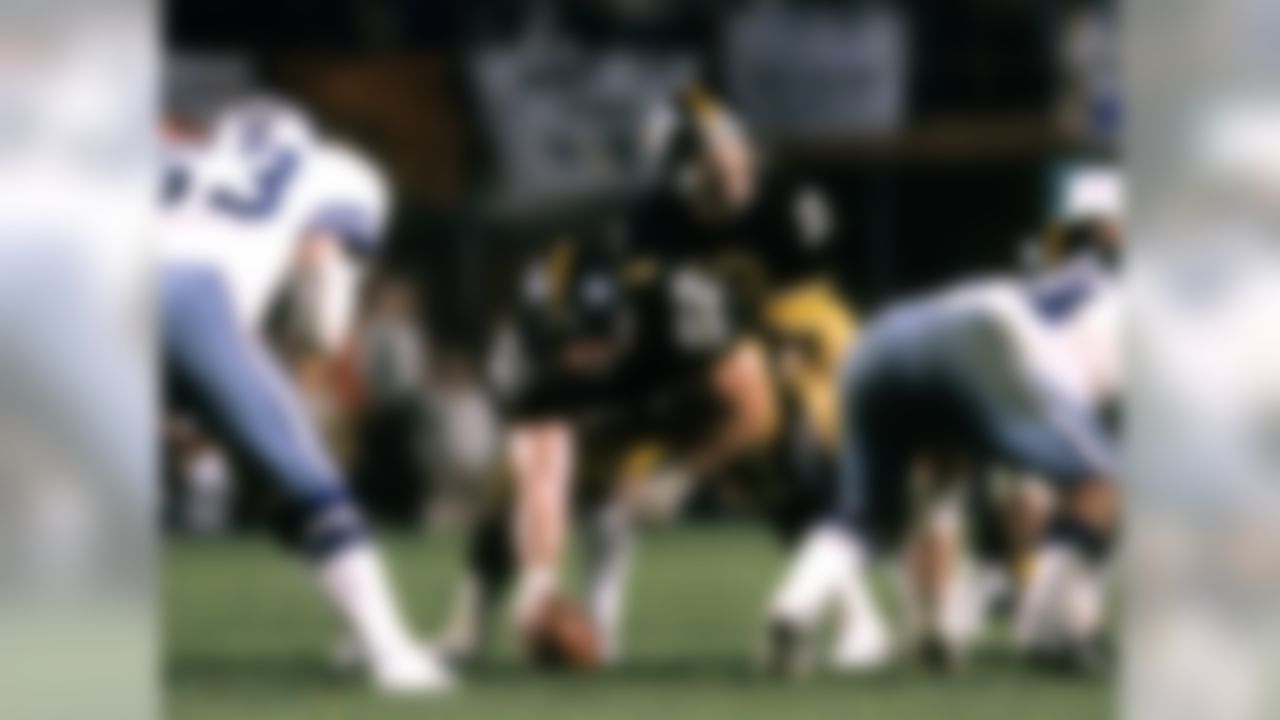
Pittsburgh Steelers center Mike Webster (52) waits to snap the ball to quarterback Terry Bradshaw (12) during Super Bowl XIII. Webster, who joined the team in the same year the Steelers won their first of four Super Bowls, also played in six AFC championship games. Pittsburgh won four of the six title games. Webster was an all-pro choice seven times and was selected to the All-AFC team five times from 1978 through 1982. He also played in nine Pro Bowls, the first five as a starter. (Photo by Al Messerschmidt/NFL)

Buffalo Bills running back O.J. Simpson, inducted into the Pro Football Hall of Fame class of 1985, during a game in 1973. O. J. Simpson, a two-time All-America from the University of Southern California and the 1968 Heisman Trophy winner, was one of history's most heralded rookies when the Buffalo Bills selected him as the No. 1 player in the entire 1969 draft. His career record for 11 seasons, the first nine in Buffalo and the 1978 and 1979 campaigns in San Francisco, confirms the rave notices were well founded. He rushed for 11,236 yards, added 2,142 yards on 203 pass receptions, returned 33 kickoffs 990 yards for a superb 30-yard average, and amassed 14,368 combined net yards. He scored 456 points on 76 touchdowns. In various selections, he was named NFL Player of the Year in 1972, 1973 and 1975. He was both All-AFC and All-Pro five straight years from 1972 through 1976. He played in six Pro Bowls, winning Player of the Game honors in the 1973 game. (Photo by Tim Culek/NFL)

Los Angeles Raiders punter Ray Guy (8) kicks the football away. Guy became the first punter ever selected in the first round of an NFL draft when the Oakland Raiders tapped him as the 23rd player chosen in 1973. The 6-3, 195-pounder from Southern Mississippi spent his entire 14-season, 207-game career with the Raiders. His career punting average was an excellent 42.4 yards and he averaged more than 40 yards 13 of his 14 seasons. He played in seven Pro Bowls and was named All-Pro six times and All-AFC seven times. (Photo by NFL/NFL)

St Louis Cardinals Hall of Fame safety Larry Wilson capitalized on the safety blitz to a degree not reached by any other pro player of the decade. Wilson won first- or second-team all-league honors seven times during his career and played in eight Pro Bowls. He reached his zenith with interceptions in seven straight games in 1966, a year that he led the NFL with 10 steals. Wilson, during his Hall of Fame career, recorded 52 career interceptions for 800 yards and five touchdowns.(Photo by NFL/NFL)

Cowboys tackle Rayfield Wright #70 of the National Conference watches from the sideline against the American Conference in the 1972 NFL Pro Bowl. Wright played a few different positions after making the team in 1967. He won the starting right tackle job in 1970 after a solid performance against Hall of Famer Deacon Jones. Wright earned first- or second-team All-NFL honors six consecutive times (1971-1976). He was also selected to play in the Pro Bowl following each of those seasons. (Photo by Darryl Norenberg/NFL Photos)

Hall of Fame linebacker Bobby Bell (78) of the Kansas City Chiefs began his college career as a quarterback, but signed with the AFL's Chiefs as a defensive end. In 1965, after winning all-league honors as a defensive end, Bell was shifted to outside linebacker. His size and speed made him ideal for the position. As a linebacker he was named All-AFL or All-NFL every year from 1965 through 1971. During his career, the versatile Bell intercepted 26 passes, returning six for touchdowns. He also scored on an onside kick and two fumble recoveries. (Photo by Rod Hanna/NFL)

Dallas Cowboys quarterback Roger Staubach earned MVP honors in Super Bowl VI after throwing for two touchdowns in a 24-3 win over the Miami Dolphins. Staubach joined the Cowboys as a 27-year-old rookie in 1969 and didn't win the regular quarterbacking job until his third season in 1971. But for the nine seasons he was in command of the potent Cowboys attack, Dallas played in six NFC championship games, winning four of them, and also scored victories in Super Bowls VI and XII. The 6-3, 200-pound Staubach wound up his career after the 1979 season with an 83.4 passing rating, the best mark by an NFL passer up to that time. His career chart shows 1,685 completions in 2,958 passing attempts, which were good for 22,700 yards and 153 touchdowns. (Photo by NFL/NFL)

Defensive back Roger Wehrli of the St. Louis Cardinals breaks up a pass in a 10 to 7 win over the Chicago Bears. He earned a starting role with the Cardinals as a rookie and contributed three interceptions and led the team in punt returns. The following season, he picked off a career-high six passes - a feat he would match in 1975 - to earn his first All-Pro and All-NFC honors. He also was named to the first of seven Pro Bowls that year. Wehrli led or tied for the lead in interceptions for the Cardinals four times during his career. He registered an interception in all but two seasons during his career and amassed a total of 40 interceptions that he returned for 309 yards. (Photo by Bruce Dierdorff/NFL)
» Video: Roger Wehrli retrospective

Ron Yary #73 of the Minnesota Vikings fends off Jack Youngblood during the 1978 NFC Divisional Playoff Game. Yary joined the Minnesota Vikings as the first player chosen in the 1968 AFL-NFL Draft. His 15-season, 207-game career included 14 years with the Vikings from 1968 to 1981 and a final season with the Los Angeles Rams in 1982. Yary won the starting right tackle job on the Vikings offensive line in his second season and played in five NFL/NFC championships and Super Bowls IV, VIII, IX and XI. He was named all-pro six times and All-NFC eight straight seasons from 1970-1977, playing in seven consecutive Pro Bowls. (Photo by Daryl Norenberg/NFL Photos)

Pittsburgh Steelers quarterback Terry Bradshaw drops back to pass against the Dallas Cowboys in Super Bowl X. Bradshaw was the first player selected in the 1970 Draft. It took the 6-3, 215-pound Louisiana Tech graduate a few seasons to adjust to the pro game but once he did, he became the dominant quarterback of the NFL and led the Pittsburgh Steelers to eight AFC Central championships, and an unprecedented four Super Bowl titles in a six-year period from 1974 to 1979. He was MVP in both Super Bowl XIII (35-31 over Dallas) and Super Bowl XIV (31-19 over the Los Angeles Rams). In four Super Bowls, he passed for an impressive 932 yards and 9 touchdowns. In 19 postseason games, he completed 261 passes for 3,833 yards. In his 14-season career, Bradshaw completed 2,025 of 3,901 passes for 27,989 yards and 212 touchdowns. (Photo by Vernon Biever/NFL)
» Video: Terry Bradshaw retrospective

Chicago Bears Hall of Fame running back Walter Payton on his way to winning the NFC rushing title five straight years from 1976 to 1980. The records he held at the time of his retirement included 16,726 total yards, 10 seasons with 1,000 or more yards rushing, 275 yards rushing in one game against Minnesota (1977), 77 games with more than 100 yards rushing, and 110 rushing touchdowns. Payton had 4,368 combined net attempts and accounted for 21,803 combined net yards. He also scored an impressive 750 points on 125 touchdowns. (Photo by Darryl Norenberg/NFL)
» Video: Walter Payton retrospective
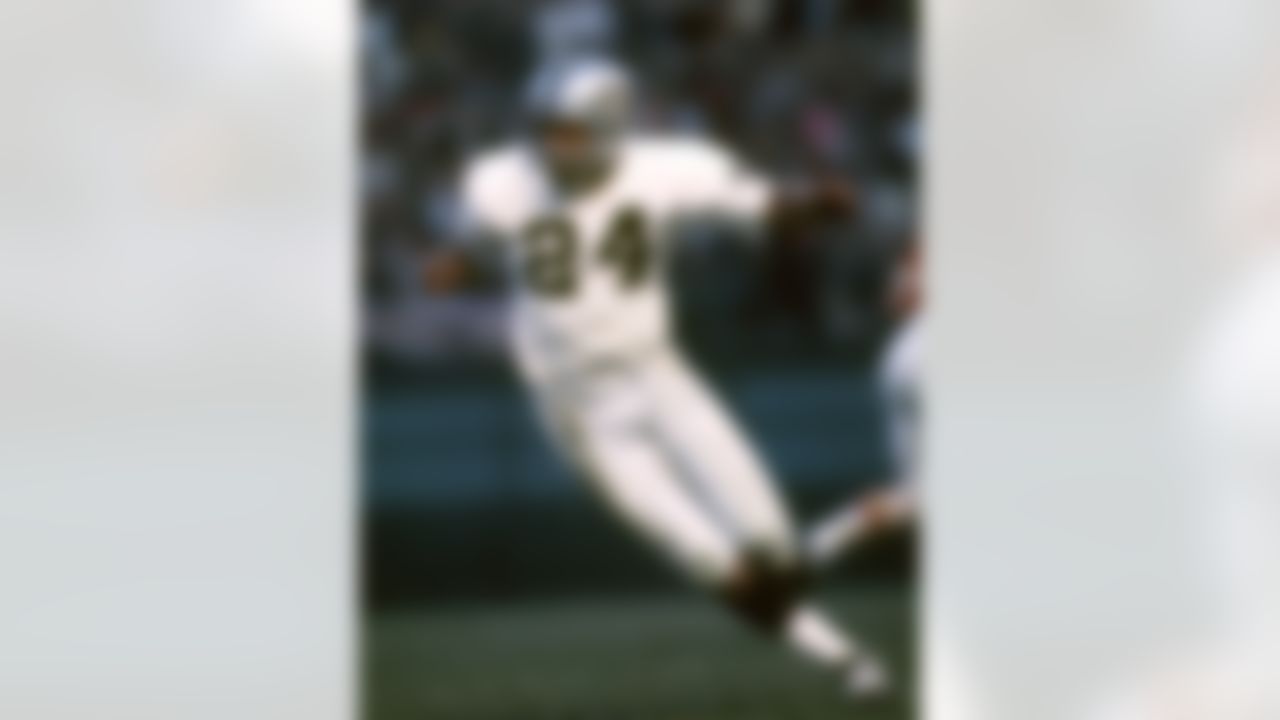
Oakland Raider Hall of Fame cornerback Willie Brown's career with the Denver Broncos and the Oakland Raiders spanned 16 seasons and 204 games from 1963 through 1978. During his 12 years in Oakland, the Raiders played in three AFL and six AFC championship games, as well as Super Bowls II and XI. Undrafted out of college, he was signed by the Houston Oilers as a free agent but cut before the end of summer camp. He then went to Denver where he became a starter midway into his rookie season. A year later, he intercepted four passes against the New York Jets to tie an all-time individual record, won All-AFL honors, and played in his first AFL All-Star game, where he was named the outstanding defensive player. (Photo by George Long/NFL)

Ted Hendricks celebrates in the Raiders 27-10 win over the Philadelphia Eagles in Super Bowl XV. The 6-7, 220-pound Hendricks was deceivingly effective. Tall and comparatively skinny, he was strong, fast and a devastating tackler who specialized in blocking punts, field goals and extra point attempts. He was the kind of player that could totally disrupt an offense. In his career, he intercepted 26 passes, which he returned for 332 yards and a touchdown. He also recovered 16 opponents' fumbles and scored a record-tying four safeties. Hendricks scored touchdowns on an interception, a fumble return, and a blocked punt. (Photo by Bill Smith/NFL)
» Video: Ted Hendricks retrospective
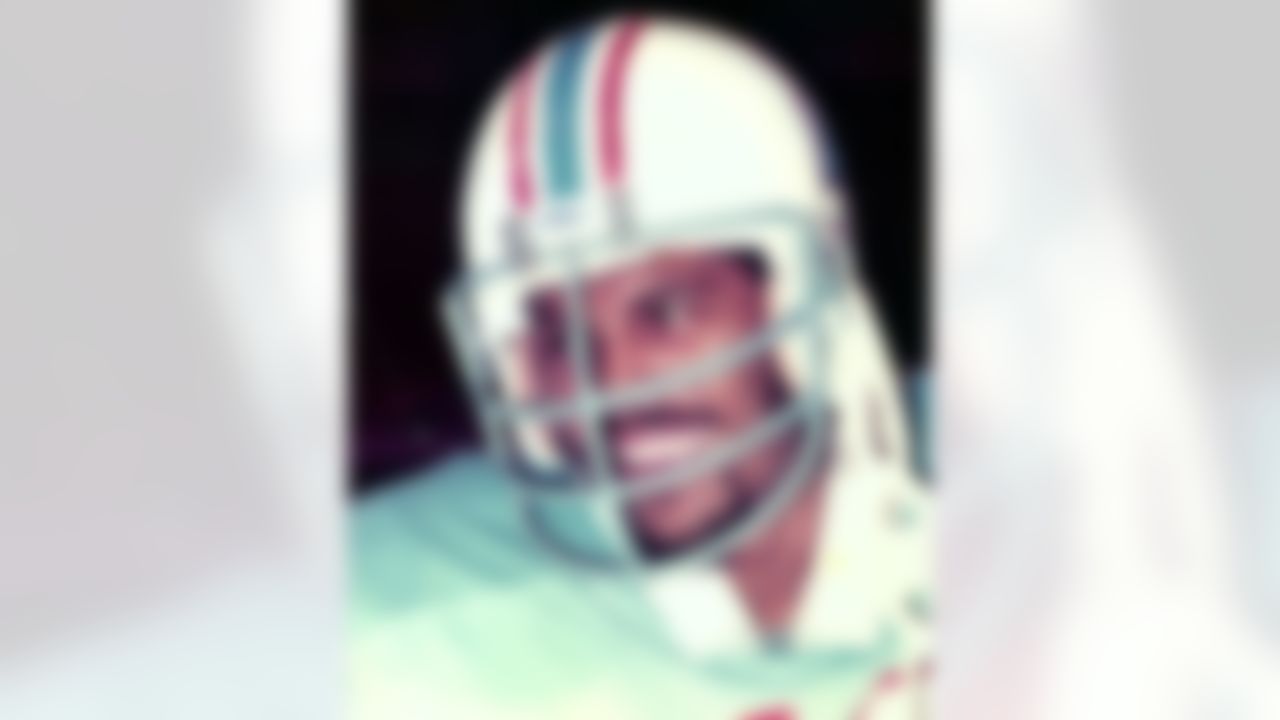
Outside linebacker Robert Brazile performed well in pass coverage and against the run, consistently ranking at or near the top for the team lead in tackles even though opponents often avoided his side of the field. Brazile found immediate success with the Oilers, winning the NFL's Defensive Rookie of the Year award for the 1975 season. He was named to the Pro Bowl in each of his first seven seasons, was All-Pro 5 straight seasons (1976-80), and was a key member of Oilers teams that went to back-to-back AFC Championship games in 1978-79. (Photo by Pro Football Hall of Fame)

Minnesota Vikings defensive end Carl Eller(81) tries to stop Pittsburgh Steelers tackle Gordon Gravelle in Super Bowl IX. After attending the University of Minnesota, Eller signed with the Vikings in 1964. For the next 15 years, he was a fixture in one of pro footballs most effective defensive alignments. He finished his career with one final season with the Seattle Seahawks in 1979, having played in 225 regular season games. During Eller's career, the Vikings enjoyed great success on the field. Starting in 1968, Minnesota won 10 NFL/NFC Central Division titles in the next 11 seasons. The Vikings won the 1969 NFL championship and NFC crowns in 1973, 1974, and 1976 and played in four Super Bowls. (Photo by Manny Rubio/NFL)

Detroit Lions tight end Charlie Sanders makes a catch in a 20-20 tied game against the New Orleans Saints. After he was selected in the 1968 draft, Sanders enjoyed instant success in the National Football League. And, by the time he retired following the 1977 season, Sanders ranked as the Lions' all-time leading receptions leader with 336 career grabs. He also scored 31 touchdowns during his 128-game career. Sanders was voted to seven Pro Bowls. He earned first- or second team all-conference selections in 1969, 1970, 1971, 1974, 1975, and 1976. (Photo by George Gellatly/NFL)

Defensive back Cliff Harris of the Dallas Cowboys runs back an interception against the Chicago Bears. Harris was not chosen in the 1970 NFL Draft out of NAIA school Ouachita Baptist College, but the Cowboys found him and invited him to training camp. He beat out Cowboys 3rd round draft choice Charlie Waters for the free safety position his rookie year. Military obligation caused him to miss the second half the season, although he returned in time for the Cowboys' victory in Super Bowl VI over the Miami Dolphins. During his career he made five Super Bowl appearances, was chosen for the Pro Bowl six consecutive times and was voted All-Pro four times. (Photo by Russ Russell/NFL)
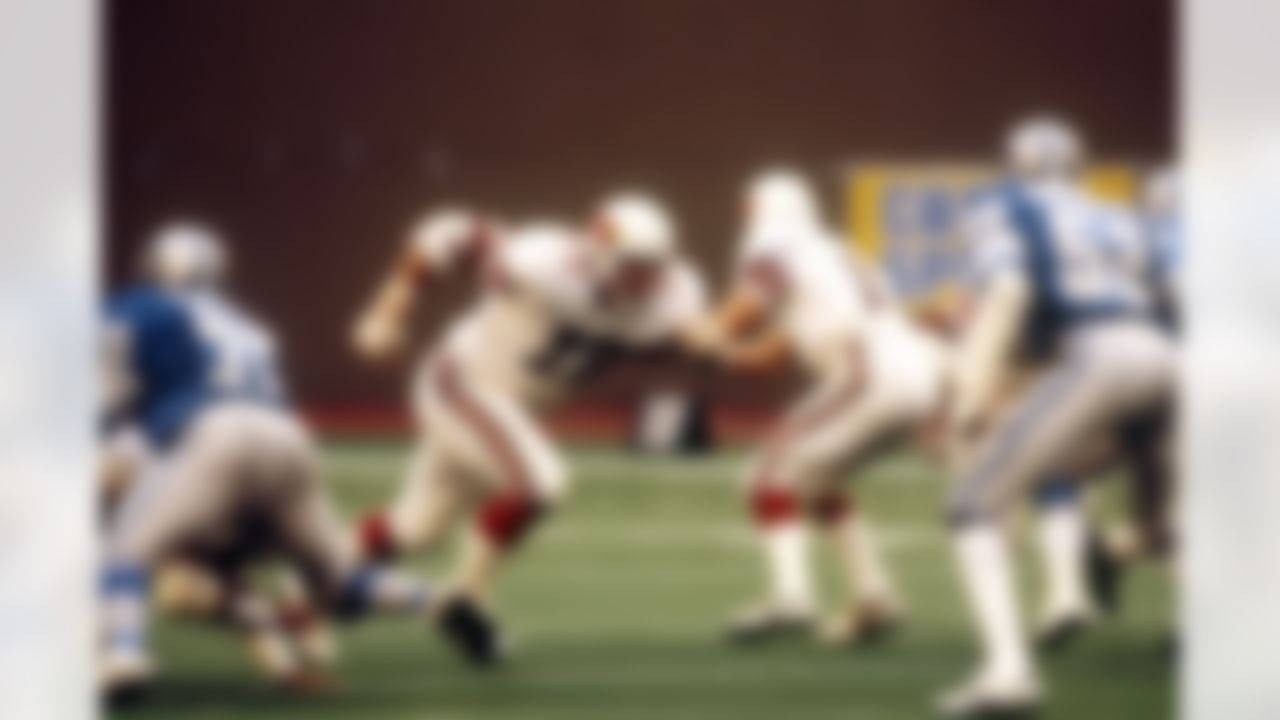
Offensive tackle Dan Dierdorf of the St. Louis Cardinals comes off the line of scrimmage. Dierdorf, who was equally effective as a blocker on both running and passing plays, was the ring-leader of the line that permitted the fewest sacks in the NFC for five straight years in the mid-1970s. Dierdorf was named All-Pro five seasons from 1975 to 1978 and again in 1980. He was elected to six Pro Bowl games, missing only once from 1974 through 1980. The NFL Players Association picked him as the best overall blocker in the NFL three straight years from 1976 to 1978. (Photo by Herbert Weitman/NFL)
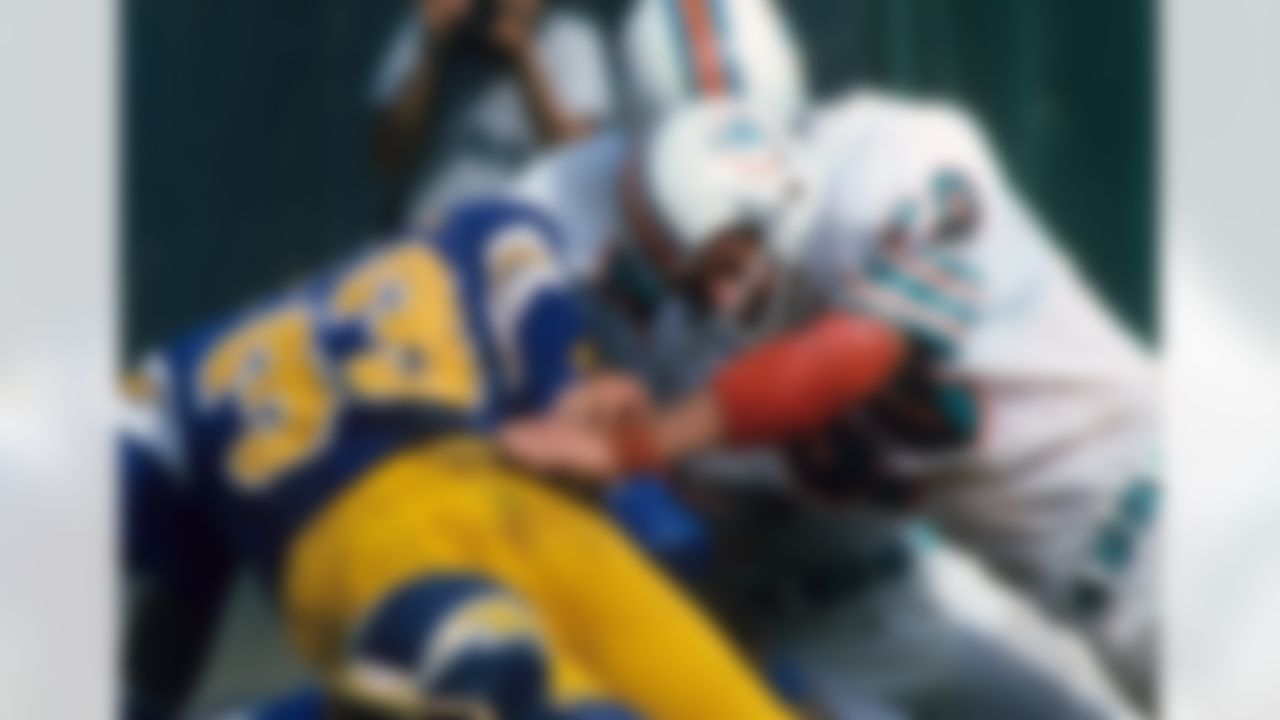
Safety Dick Anderson #40 was drafted by the Dolphins in the 1968 AFL Draft, preceding a season in which he was named the league defensive rookie of the year. He was a three time Pro Bowler in 1972, 1973, in which he was NFL Defensive Player of the Year, and in 1974, in which he was one of the leaders of the Dolphins well known "No Name Defense." In his 9 AFL/NFL seasons, Anderson recorded 34 interceptions, which he returned for 792 yards and 3 touchdowns. He also recovered 15 fumbles, returning them for 100 yards and a touchdown. On special teams, he gained 430 yards returning kickoffs and punted the ball 9 times for 335 yards. (Photo by James Flores/NFL Photos)

Chicago Bears linebacker Dick Butkus #51 in the 1971 NFL Pro Bowl. He played as the Chicago Bears' middle linebacker for nine years with only one goal in mind - to be the best, and from the very start, he was just that. In his rookie season, Butkus, a first-round draft choice, had only one challenger for National Football League Rookie of the Year honors, teammate Gale Sayers. That same year Butkus was named first-team All-NFL, an honor he would record five more times. Butkus also played in the Pro Bowl following his rookie season and in each of the next seven years. He even figured in the career statistical columns with 22 interceptions and 27 opponents' fumble recoveries. (Photo by NFL Photos/Getty Images)

Dallas Cowboys wide receiver Drew Pearson (88) catches the football for a first down. In 1973, Pearson was selected as a free agent by the Dallas Cowboys, where he rose to become one of the NFL's greatest wide receivers, earning career records of 489 receptions and 7,822 receiving yards, along with 189 rushing yards, 155 yards returning kickoffs, and 50 touchdowns (48 receiving and 2 fumble recoveries). Named one of the Top 20 Pro Football All-Time Wide Receivers, he was also named All-Pro 3 times (1974, 1976-77) All-NFC in 1975 and 2nd Team All-NFC in 1978. In addition, Pearson was a Pro Bowler in 1974, 1976 and 1977. (Photo by Jay Dickman/NFL)

Earl Campbell, a 5-11, 232-pound ball-carrying dynamo from the University of Texas, joined the Houston Oilers as the first player taken in the 1978 Draft. In 1978, he was named the NFL's Most Valuable Player, All-Pro, and Rookie of the Year. He won the league rushing championship with 1,450 yards and was named to the AFC Pro Bowl squad. It was more of the same the next two years with NFL rushing titles, MVP honors, and consensus All-Pro acclaim each season. His finest year came in 1980, however, when he rushed for 1,934 yards, which at the time was second only to 0. J. Simpson's 2003 yards gained in 1973. (Photo by NFL/NFL)
» Video: Earl Campbell retrospective

Pittsburgh running back Franco Harris carries the ball in the Steelers 21-17 win over the Cowboys in Super Bowl X. For 12 seasons, the 6-2, 230-pounder from Penn State was a big-yardage running back, a key man in the powerful Pittsburgh offensive machine. Harris established himself as a future superstar when he became only the fourth rookie in NFL annals to rush for 1,000 yards. He gained additional attention by being on the receiving end of the famous "Immaculate Reception" pass from Terry Bradshaw that gave the Steelers their first-ever playoff win. He rushed for 1,000 yards or more eight seasons and for more than 100 yards in 47 games. He also caught 307 passes for 2,287 yards and nine touchdowns. His career rushing total and his combined net yardage figure of 14,622 both ranked as the third highest marks in pro football history at the time of his retirement. (Photo by Takashi Makita/NFL)

Kicker Garo Yepremian of the Miami Dolphins also played for the Detroit Lions, New Orleans Saints, and Tampa Bay Buccaneers during a career that spanned from 1966 to 1981. In 1970, Yepremian led the league in points with 117 in 1971. He was a key member of the 1972 Miami Dolphins unbeaten team and appeared in three Super Bowls (VI, VII and VIII). In a divisional playoff game against the Kansas City Chiefs on Christmas 1971, he kicked a 37-yard field goal 7 minutes and 40 seconds into double overtime, ending the longest game in NFL history and sending the Dolphins to the AFC Championship game. (Photo by Dave Cross/NFL)

Oakland Raiders guard Gene Upshaw was the Oakland Raiders' first-round choice in the first combined AFL-NFL draft in 1967. He won the starting left guard job in his rookie training camp and held the guard spot for the next 15 seasons, starting in 207 straight regular season games until finally being forced out of action for one game in 1981. Altogether Upshaw played in an incredible 307 preseason, regular season, and post-season contests. Included in his 24 post-season games were three AFL and seven AFC championship games and Super Bowls II, XI and XV. Counting the AFL championship in 1967 and victories in Super Bowls XI and XV, Upshaw became the only player ever to start on championship teams in both the AFL and NFL. (Photo by Al Messerschmidt/NFL)

Philadelphia Eagles wide receiver Harold Carmichael (17) in 1969. Carmichael was elected to four Pro Bowls in his NFL career, and led the league in receptions and receiving yards during the 1973 season. He finished third in receiving yards in 1978 with 1,072 and was second in receiving touchdowns in 1979 with 11. He was also the Eagles' top receiver of Super Bowl XV, with 6 catches for 91 yards. He ended his career with 590 receptions for 8,985 yards with 79 career touchdown catches, along with 64 rushing yards on 9 carries. He still ranks 18th all-time in career touchdown receptions. (Photo by NFL/NFL)

Linebacker Jack Ham of the Pittsburgh Steelers covers the field waiting for the ball to come his way. His sensational rookie training camp in 1971 earned him a starting left linebacker spot in his first regular season game. The clincher was a three-interception performance against the New York Giants in the preseason finale. Ham started all 14 games as a rookie and he continued to hold a regular job until his retirement after the 1982 season. He wound up his career with 25 sacks, 21 opponents' fumbles recovered and 32 interceptions. (Photo by Manny Rubio/NFL)

Dallas defensive end Harvey Martin sacks Denver's Craig Morton during Super Bowl XII. As part of the famed Doomsday Defense, Martin led the Cowboys in sacks seven times. He went to the Pro Bowl four times and was co-Super Bowl MVP in Super Bowl XII (shared with teammate Randy White). He still holds team records for most sacks as a rookie (8 - 1973), in a season (23 - 1977), and career (114). Martin followed up his 20-sack 1977 season with a 14 sack performance in 1978, 9 in 1979, and 12 in 1980. (Photo by Vernon Biever/NFL)

St. Louis Cardinals kicker Jim Bakken #25 of the East kicks a field goal against the West in the 1966 NFL Pro Bowl. Bakken was a four time Pro Bowl seleection and set an NFL record in 1967 when he made 7 field goals in one game. The record has since been equaled three times, and finally broken in 2007. (Photo by NFL Photos/Getty Images)

Miami Dolphins Hall of Fame center Jim Langer blocks for Hall of Fame fullback Larry Csonka in a 14-7 win over the Washington Redskins in Super Bowl VII. Langer was named All-Pro and All-AFC six straight years from 1973 to 1977 and was also picked for the Pro Bowl six straight times. During that period, he started in three AFC championship games and Super Bowls VI, VII and VIII. Many qualified observers insist that Langer was the most proficient performer on a talent laden offensive line that fueled Miami's vaunted ball-control offense. Langer wound up playing every offensive down in Miami's perfect season. (Photo by James Flores/NFL)

Pittsburgh Steelers defensive end L.C. Greenwood during a 31-19 win over the Los Angeles Rams in Super Bowl XIV. He joined the Pittsburgh Steelers as a 10th-round choice in the 1969 NFL Draft. The 6-6, 245-pound Greenwood served as a fifth defensive lineman his first two seasons before becoming firmly entrenched as the Steelers' regular defensive left end in 1971. That year he led the team in sacks (8.5) and shared the NFL lead in fumble recoveries (5). For the next 11 seasons, Greenwood teamed with Joe Greene at left tackle to provide the Steelers' famed "Steel Curtain" defensive unit with awesome strength on the left side of the front line. The "Steel Curtain" formed the heart of a legendary defense that led Pittsburgh to four Super Bowl victories and seven division titles. (Photo by Bill Smith/NFL)

Defensive back Jimmy Johnson #37 of the San Francisco 49ers intercepted five passes in his rookie season but also did well with 34 receptions for 627 yards and four touchdowns as an offensive receiver in 1962. Recognized as one of the best man-to-man defenders in history, Johnson's reputation was so great that opposition quarterbacks threw only rarely into his defensive territory. Still, Johnson intercepted 47 passes and returned them 615 yards. (Photo by Clifton Boutelle/NFL Photos)

Hall of Fame defensive end Jack Youngblood (85) of the Los Angeles Rams stops Cardinals running back Terry Metcalf. The Rams defensive captain, Youngblood was a three-time winner of the Dan Reeves Award given to that team's most valuable player. Youngblood was All-Pro in 1974, 1975, 1976, 1978, and 1979 and All-NFC seven times. He played in seven straight Pro Bowls following each season from 1973 to 1979.
» Video: Jack Youngblood retrospective



